
Leucadendron strobilinum, commonly called the peninsula conebush, is a plant species in the genus Leucadendron—forming part of the family Proteaceae. Confined to the Cape Peninsula of South Africa, it reaches a height of up to 2.6 metres growing in southern, damp rocky slopes at an elevation of 500 to 1100m. Its conservation status is Near Threatened—a result of inappropriate fire management, fire-break clearing and alien plant invasions.

Leucadendron laureolum, common names golden conebush and laurel leaf conebush, is a species of plant in the family Proteaceae. It is endemic to the southwestern Cape Provinces of South Africa, and also cultivated. It is a large bush that turns bright yellow in the winter flowering season.

Leucadendron salignum, also known as the common sunshine conebush, is an evergreen, dioecious shrub in the family Proteaceae. It produces several stems from the ground of up to 2 metres high. It survives the wildfires that occur every one or two decades in the fynbos, where it occurs, by regrowing from an underground rootstock. Pollinated by beetles, it flowers from April to November. The winged seeds remain in the woody cones until they are released after a fire, and are distributed by the wind. It is possibly the most common Proteaceae species in South Africa, and can be found in the Northern Cape, Western Cape and Eastern Cape provinces. Its current conservation status is Least Concern.
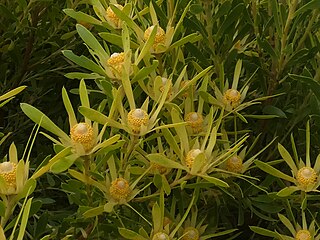
Leucadendron coniferum, also known at the dune conebush, is an evergreen, dioecious shrub or small tree of up to 4 m (13 ft) high, that has been assigned to the family Proteaceae. It has a whorl of conspicuous yellow leaves subtending the flowerheads. The flowers can be found in August and September. It grows in sandy soils near the coast of the Western Cape province of South Africa.

Leucadendron barkerae, the Swartberg conebush, is a flower-bearing shrub that belongs to the genus Leucadendron and forms part of the fynbos. The plant is native to the Western Cape, South Africa.

Leucadendron corymbosum, the swartveld conebush, is a flower-bearing shrub that belongs to the genus Leucadendron and forms part of the fynbos. The plant is native to the Western Cape and occurs from Michells Pass to Paarl. The shrub grows up to 2 m high.
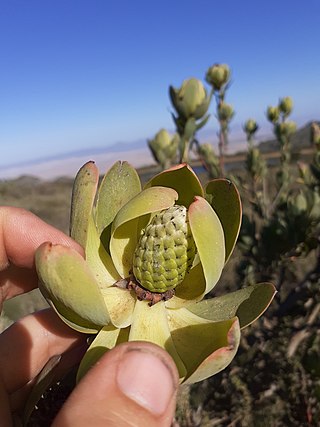
Leucadendron diemontianum, the Visgat conebush, is a flower-bearing shrub belonging to the genus Leucadendron and forms part of the fynbos. The plant is native to the Western Cape where it occurs on the foothills of the Great Winterhoek Mountains at Visgat, Onderboskloof and Rosendal as well as at Heuningvlei in the northern Cederberg.

Leucadendron dregei, the summit conebush, is a flower-bearing shrub belonging to the genus Leucadendron and forms part of the fynbos. The plant is native to the Western Cape, South Africa.
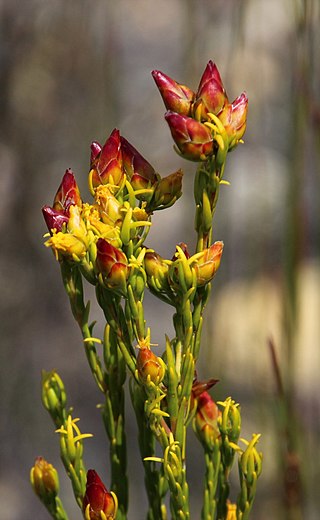
Leucadendron olens, the yellow conebush, is a flower-bearing shrub that belongs to the genus Leucadendron and forms part of the fynbos. The plant is native to the Western Cape, South Africa.

Leucadendron procerum, the ivory conebush, is a flower-bearing shrub that belongs to the genus Leucadendron and forms part of the fynbos. The plant is native to the Western Cape, South Africa.

Leucadendron salicifolium, the common stream conebush, is a flower-bearing shrub belonging to the genus Leucadendron and forms part of the fynbos. The plant is native to the Western Cape where it occurs from Porterville to Kogelberg and Langeberg.
Leucadendron thymifolium, the Malmesbury conebush, is a flower-bearing shrub belonging to the genus Leucadendron and forms part of the fynbos. The plant is native to the Western Cape, South Africa.

Leucadendron spissifolium subsp. fragrans, the fragrant spear-leaf conebush, is a flower-bearing shrub belonging to the genus Leucadendron. The plant is native to the Western Cape and occurs in the Langeberg and Outeniqua Mountains from Gysmanshoek to the Woodville Forest Reserve, as well as the Swartberg and Kammanassie Mountains. It forms part of the fynbos.

Leucadendron brunioides var. brunioides, the common foetid conebush, is a flower-bearing shrub and variety of Leucadendron brunioides, which belongs to the genus Leucadendron and forms part of the fynbos. The plant is native to the Western Cape where it occurs on the Bokkeveld Carp near Nieuwoudtville, the Sandveld, Gifberg, Cederberg to the eastern Koue Bokkeveld, Hex River Mountains, and the Breede River Valley.

Leucadendron brunioides var. flumenlupinum, the Graafwater conebush, is a flower-bearing shrub and variety of Leucadendron brunioides, which belongs to the genus Leucadendron and forms part of the fynbos. The plant is native to the Western Cape where it occurs from Graafwater to Aurora and Eendekuil.
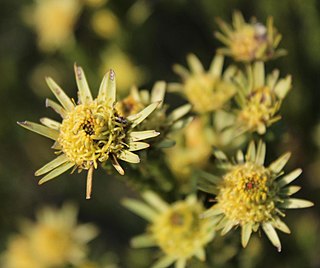
Leucadendron stellare, the star conebush, is a flower-bearing shrub belonging to the genus Leucadendron. It forms part of the fynbos biome. The plant is native to the Western Cape where it occurs from the Cape Flats to the Berg River Valley and plains at Aurora.
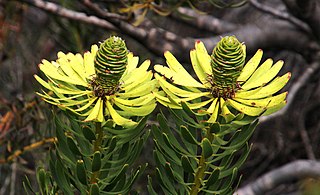
Leucadendron platyspermum, the plate-seed conebush, is a flower-bearing shrub belonging to the genus Leucadendron. It form part of the fynbos biome. The plant is native to the Western Cape, where it occurs from the Donkerhoekberg near Villiersdorp, Groenlandberg, and Kleinmondberge from Houhoek to the Elimvlakte.
Leucadendron sheilae, the Lokenberg conebush, is a flower-bearing shrub that belongs to the genus Leucadendron and forms part of the fynbos, a South African biogeographical region. The plant is native to the Western and Northern Capes, where it occurs at Lokenberg in the Bokkeveld Mountains. The plant grows mainly in hard sandstone sand on level crests at altitudes of 600 to 900 metres (2,000–3,000 ft). In Afrikaans it is known as Lokenberg-tolbos.

Leucadendron spissifolium, the spear-leaf conebush, is a species of plant in the family Proteaceae. It was first described in 1809 as Euryspermum spissifolium. It was renamed Leucadendron spissifolium in 1967.


















